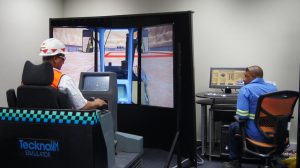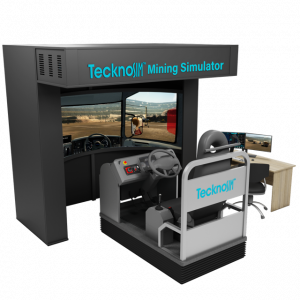When we think of the military and defence, we often picture soldiers in uniforms fighting on the border with guns and ammunitions. But did you know that not all soldiers engage in direct combat? The military has various branches and occupations that serve different functions, including engineering and construction. Soldiers who are trained in engineering and construction are assigned to tasks such as building roads, bridges, and other infrastructure to support military operations. Additionally, some soldiers are assigned to logistics and supply roles, which involve supporting combat troops by ensuring they have the necessary equipment, supplies, and resources.
In this article, we’ll explore what it takes a military engineer to become a trained heavy earth-moving equipment operator and how their Heavy Earth Moving Equipment Simulators are helping the armed forces to train better .
Use of HEMM construction equipment in military and defence
The military uses heavy earthmoving equipment for a variety of tasks, such as building fortifications, digging trenches, constructing roads and bridges, and clearing obstacles. Additionally, heavy equipment also provides protection for military personnel by allowing them to remain behind cover while completing these tasks. These machines are often modified with armour and other protective measures to make them suitable for use in combat zones.
The military uses a variety of heavy earthmoving equipment, including:
1. Bulldozers – used for grading, levelling, and pushing large quantities of earth or debris.
2. Excavators – used for digging trenches, demolishing structures, and digging foundations.
3. Graders – used for levelling and smoothing roads, airfields, and other flat surfaces.
4. Loaders – used for moving soil, sand, and other materials.
5. Scrapers – used for moving large quantities of earth for construction or road-building
projects.
6. Backhoes – used for digging trenches and excavating foundations.
7. Dump truck – used for lifting and dumping materials from one place to another
8. Rollers – used for compacting soil and other materials to create a smooth surface.
9. Pavers – used for laying asphalt or concrete for road construction.
The Indian Armed Forces use heavy earthmoving equipment for a variety of tasks such as building fortifications, constructing roads, airstrips, and bridges, and clearing obstacles. The three main branches of the Indian Armed Forces, the Indian Army, Indian Navy, and Indian Air Force, all have their own engineering units that are responsible for conducting these tasks. The Indian Army, for example, has a dedicated Corps of Engineers that is responsible for providing engineering support to the Army during war and peace. The Corps of Engineers is equipped with a variety of heavy earthmoving equipment, such as bulldozers, excavators, graders, loaders, scrapers, and rollers, to support its operations.
BRO – a statutory body under the ownership of the Ministry of Defence, Government of India manages infrastructure operations in 19 states and three union territories and has constructed over 55,000 kilometres (34,000 mi) of roads, over 450 permanent bridges with a total length of over 44,000 metres (27 mi) length and 19 airfields in strategic locations by 2022.
Similarly, the Indian Navy and Indian Air Force also have their own engineering units that are responsible for providing engineering support to their respective branches. The Indian Navy’s Seabees and the Indian Air Force’s Airfield Construction Squadron both use heavy earthmoving equipment to construct and maintain their respective infrastructure.
Why is simulator training becoming increasingly important for the military?

Providing skilled labour in remote areas can be a challenge for the military, as these areas may be difficult to access and lack the necessary infrastructure to support military operations. In some cases, there may also be a shortage of skilled labour in these areas, which can make it difficult for the military to carry out its operations effectively.
To address these challenges, the military provides regular training and support to local communities to help build their capacity and develop the necessary skills to support military operations. This includes training programs in areas such as construction, logistics, and communications, as well as providing resources and equipment to support these efforts. Though military has been using traditional operator training methods which involves hands-on training with real equipment and machinery allows soldiers to become familiar with the equipment, they are realising that it’s time consuming and expensive. Also, it does not have the ability to develop situational awareness and decision-making skills in difficult environments
Simulator training is playing an increasingly important role in preparing military engineers for their roles. Simulator training is allowing military engineers to train in realistic, high-stress environments without the need for costly and potentially dangerous live training exercises. Some of its benefits include:
• Remote Training Accessibility: Simulator training provides the flexibility for operators to access training remotely from any location at any time of the day or in any weather condition.
• Realistic and Safe Simulator training is virtual yet realistic along with being immersive, replicating a wide range of scenarios and environments, allowing soldiers to practice in conditions that may be difficult or impossible to reproduce in real life.
• Cost-Effective training: Simulator training often eliminates the need for physical training facilities, travel, and equipment setup costs, making it a more cost-effective option for both operators and training providers.
• Self-Paced Learning: Virtual training may offer self-paced learning opportunities, allowing operators to progress at their speed and revisit modules or concepts as needed.
• Realtime assessment and learning: One of the benefits of simulator training is that is gives realistic feedback of the trainee’s performance that enables them to correct their mistakes and learn better and faster.
The HEMM Construction Equipment Simulator’s Role in Global Military Advancements

Construction equipment training simulators or heavy earthmoving equipment simulators are highly realistic replicas of actual types of equipment like excavators, dozers, loader, grader, scraper, and dumper. Simulator is based on a mockup of an actual equipment with fully functional controls. The seamless virtual display screen in front immerses the trainee in the virtual training environment. The rear screen allows the operators to view the rear of the equipment while operating just like in real life. This setup provides a realistic and immersive environment for operators to develop their skills and proficiency in handling various types of equipment, including those manufactured by CAT, Volvo, BEML, JCB, Terex, Komatsu, and other leading brands.
The demand for military simulator systems is rapidly increasing especially in emerging economies like the Asia-Pacific region, including India and China. Militaries in Saudi Arabia ,Africa Philippines, Indonesia , UAE , South Africa and Militaries are incorporating simulators into their training programs to cut down various operating costs associated with the training involved with real equipment. The US Armed forces is using heavy earth moving equipment simulators to train their army. The biggest challenge for US Armed forces was to get soldiers to overcome their fear of operating real equipment, which is large, noisy, and cumbersome. Construction Equipment Training Simulators are helping their US Army soldiers overcome the fear of operating heavy equipment and skill themselves before they get on with the actual task. Simulator training is giving the soldiers the ability to practice the same task repeatedly until they master the skill.
Indian Armed Forces is also implementing simulation-based training across all military domains and train combatants, leaders, maintainers, and administrators to achieve cost-effective, efficient, safe, fast-paced, and smart training. Indian Military Schemes like Agnipath have been designed to train soldiers with modern technology like simulators and bring about a transformational shift towards a more tech-savvy military.
Tecknotrove specializes in the design and development of construction equipment simulators since the past 20 years. The training simulators are designed for a range of heavy earth moving equipments that provide training for critical applications. Tecknotrove sets up complete simulation training centre which includes full motion simulator, VR training simulations and Desktop Simulators for military and defence. In addition, Tecknotrove offers military vehicle simulators, military tank simulators, firearm training simulators, aircraft, and helicopter maintenance training systems. To know more about simulator training solutions for military getin touch with our team at sales@tecknotrove.com.

